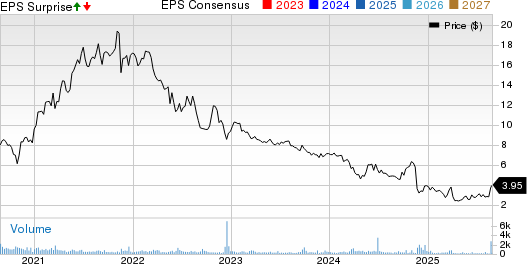Cato's Q2 Earnings Jump Y/Y on Same-Store Sales Growth
Shares of The Cato Corporation CATO have surged 39.1% since the company reported its fiscal second-quarter results on Aug. 2, 2025, far outpacing the S&P 500 index’s modest 0.8% growth over the same period. Over the past month, the stock has advanced 32.1% compared with a 1% increase in the broader benchmark, reflecting strong investor enthusiasm following the earnings release.
In the second quarter, Cato reported net income of 35 cents per share, up from 1 cent per share in the same quarter last year.
Sales increased 5% year over year to $174.7 million from $166.9 million, driven largely by a 9% same-store sales increase. This performance underscores a sharp improvement in profitability compared to the prior year, when supply chain disruptions weighed on results.
Cato’s net income of $6.8 million denoted a significant jump from $0.1 million in the same quarter last year.
Other Key Business Metrics
Gross margin improved to 36.2% of sales in the quarter, up from 34.6% a year earlier. The expansion was attributed to lower distribution and buying costs, partially offset by reduced merchandise margins. Selling, general and administrative (SG&A) expenses also declined as a share of sales, falling to 32.8% from 34.9% in the prior-year quarter, reflecting lower payroll and insurance costs despite higher advertising and corporate expenses.
Management Commentary
Chairman, president, and CEO John Cato noted that sales trends continued to improve in the second quarter, partly because last year’s results were negatively impacted by supply chain disruptions. However, management remained cautious, highlighting uncertainty in the second half of 2025 tied to tariffs and potential cost pressures on product acquisition. The company emphasized its ongoing focus on managing expenses tightly to navigate these challenges.
Factors Influencing Results
Several elements contributed to the quarter’s stronger showing. Improved same-store sales growth was a key driver, reflecting healthier consumer demand and more stable inventory flows. The improved gross margin benefited from reduced distribution and buying costs, while lower payroll and insurance expenses helped reduce SG&A. At the same time, the company recognized some offsetting factors, including lower merchandise margins and rising advertising and corporate costs.
Income tax treatment also played a role in boosting profitability, with Cato recording a $0.3 million tax benefit in the quarter compared with a $0.6 million expense in the year-ago period.
Outlook
Management pointed to uncertainty surrounding tariffs, inflationary pressures, and their potential negative impact on product acquisition costs. Broader macroeconomic conditions, such as consumer confidence, unemployment levels, and discretionary spending trends, were also highlighted as key variables that could affect future performance.
Other Developments
During the quarter, Cato closed eight stores, bringing its total store count to 1,101 in 31 states as of Aug. 2, 2025, down from 1,166 stores a year earlier. The store rationalization underscores management’s ongoing efforts to balance footprint optimization with growth initiatives across its three retail concepts: Cato, Versona and It’s Fashion.
Beyond Nvidia: AI's Second Wave Is Here
The AI revolution has already minted millionaires. But the stocks everyone knows about aren't likely to keep delivering the biggest profits. Little-known AI firms tackling the world's biggest problems may be more lucrative in the coming months and years.
See "2nd Wave" AI stocks now >>Want the latest recommendations from Zacks Investment Research? Today, you can download 7 Best Stocks for the Next 30 Days. Click to get this free report
Cato Corporation (The) (CATO): Free Stock Analysis Report
This article originally published on Zacks Investment Research (zacks.com).
Contact Us
Contact Number : +852 3852 8500Service Email : service@webull.hkBusiness Cooperation : marketinghk@webull.hkWebull Securities Limited is licensed with the Securities and Futures Commission of Hong Kong (CE No. BNG700) for carrying out Type 1 License for Dealing in Securities, Type 2 License for Dealing in Futures Contracts and Type 4 License for Advising on Securities.

English
